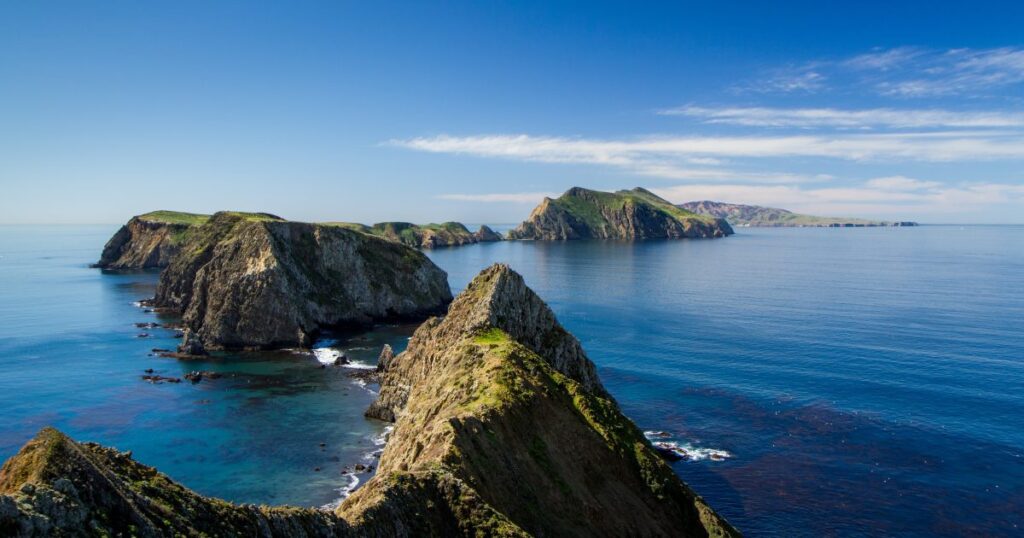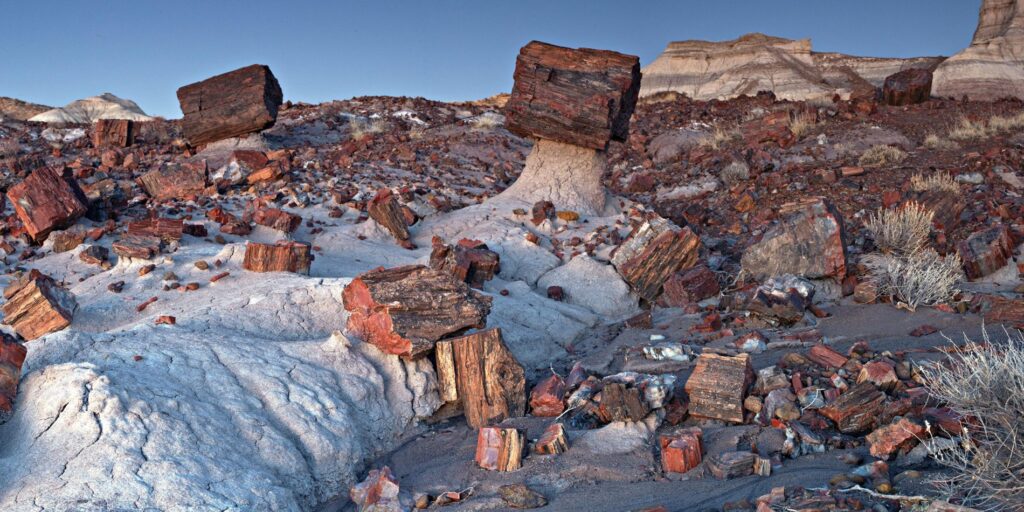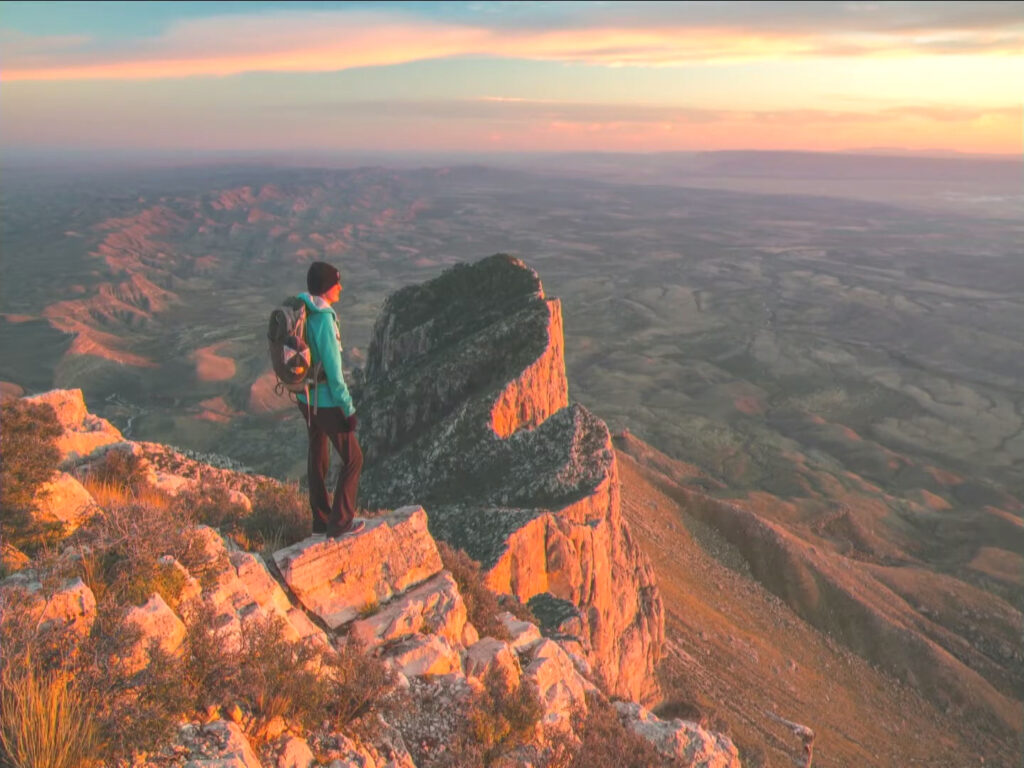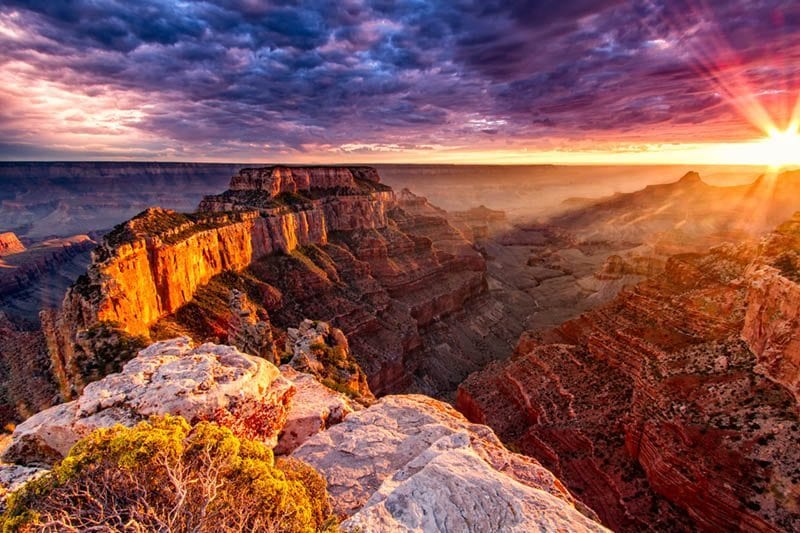The United States is a land of astonishing natural beauty, and its national parks serve as windows to some of the most spectacular and awe-inspiring wonders nature offers. From the rugged canyons and deep forests to the misty mountains and bubbling geysers, these national parks are true treasures, each with unique charm and natural marvels.
This article embarks on a journey to introduce you to the captivating world of natural wonders nestled within the national parks of the United States. These parks are not just protected lands but veritable showcases of Earth’s artistry, spanning the entire nation and catering to the diverse tastes of outdoor enthusiasts, adventurers, and nature lovers.
The focus of this article is to provide you with a comprehensive overview of the captivating natural wonders awaiting your discovery. It’s not just about naming these wonders but unraveling the stories they hold, the science behind their formation, and the experiences they offer. Whether you’re planning a future adventure, reminiscing about past journeys, or simply seeking to connect with the beauty of the natural world, this article has something for you.
In the following pages, you’ll delve into the diversity of U.S. national parks, from the iconic landscapes to the hidden gems that often escape the limelight. You’ll explore the mystical beauty of the Great Smoky Mountains, the rugged wilderness of Yellowstone National Park, the pristine lakes and glaciers of Glacier National Park, and the coastal marvels of Acadia National Park. We’ll also venture into the red rock majesty of Arches National Park and dive into the underwater wonders of Biscayne National Park.
Each section will uncover these wonders’ allure, significance, and unique characteristics, making you appreciate the natural world in a new way. These parks are not just places to visit; they are geology, biology, ecology, and history classrooms.
As we journey through the articles, you’ll discover why conservation is vital to preserving these wonders for future generations, and you’ll gain insight into the various activities and experiences that await visitors. Lastly, for those eager to plan their adventures, we’ll provide practical tips to make the most of your visit to these magnificent natural wonders.
The Diversity of U.S. National Parks: Exploring Nature’s Kaleidoscope
The United States boasts a natural heritage that is as diverse as stunning. This diversity is beautifully showcased within the country’s expansive national parks system. From the towering peaks of the Rocky Mountains to the lush, verdant forests of the Appalachian Trail, U.S. national parks are a true testament to the nation’s remarkable natural beauty.
In this section, we embark on a journey to explore the vast range of national parks in the U.S., each offering a unique tapestry of geographic and ecological features. These parks are like a kaleidoscope; every twist reveals a new and breathtaking scene.
A Geographic Wonderland
The geography of U.S. national parks is a testament to the geological history of North America. The Grand Canyon in Arizona stands as an iconic symbol of geological wonder. Carved by the mighty Colorado River over millions of years, the Grand Canyon is a breathtaking chasm that exposes the Earth’s geological history layer by layer. Its immense size and the intricate play of light and shadow make it a must-see for any nature enthusiast.
For those who seek the otherworldly, Arches National Park in Utah offers a stark and surreal landscape of red rock formations. The park is a sculptor’s dream, with over 2,000 natural sandstone arches, each a masterpiece of nature’s artistry. As the sun sets, these arches become fiery spectacles, casting long shadows across the barren terrain.
Journeying eastward, the Great Smoky Mountains National Park, straddling the border of North Carolina and Tennessee, provides a lush and misty wilderness. This ancient mountain range is home to diverse flora and fauna, including some species found nowhere else on Earth. The park’s name is a nod to the smoky, bluish haze that often shrouds the mountains, creating an enchanting and mystical ambiance.
Far to the north, Glacier National Park in Montana boasts rugged beauty in the form of pristine lakes and towering glaciers. This park is a testament to the power of ice and time, with towering peaks and shimmering waters that leave visitors in awe.
Ecological Diversity
The ecological diversity found within U.S. national parks is equally impressive. The range of ecosystems is astounding, from the subtropical wilderness of the Everglades in Florida to the alpine tundra of Denali National Park in Alaska.
In Biscayne National Park, the wonders are hidden beneath the waves. This underwater wonderland, just off the coast of Miami, is a paradise for snorkelers and divers. The park’s coral reefs teem with colorful fish and other marine life. It’s a testament to the incredible biodiversity of our oceans.
Acadia National Park, located in Maine, uniquely combines coastal and mountain ecosystems. Visitors can explore rocky cliffs, islands, and the tallest peak on the U.S. Atlantic coast, Cadillac Mountain. The park is a haven for birdwatchers and hikers, providing a serene escape into nature.
As you explore the vast array of national parks in the United States, you’ll be amazed by the unique landscapes, geological formations, and ecological wonders that make each one special. Whether you’re a hiker, a nature lover, or simply an admirer of Earth’s beauty, these parks have something for everyone. They are living testaments to the incredible diversity of the U.S. natural landscape, and they invite you to become a part of their enduring story.
Hidden Gems: Lesser-Known Wonders of U.S. National Parks
Regarding U.S. national parks, the Grand Canyon, Yellowstone, and Yosemite often steal the spotlight. While these iconic parks are rightfully celebrated, hidden gems are scattered across the country, quietly enchanting those who venture off the beaten path. This section will uncover some of these lesser-known natural wonders within national parks. These treasures often escape the limelight but are no less deserving of awe and admiration.
Gems Along the Pacific Coast: Channel Islands National Park

Nestled off the coast of Southern California, Channel Islands National Park is an untouched wilderness, often referred to as “The Galapagos of North America.” This archipelago comprises five rugged islands with diverse ecosystems. Anacapa Island, for instance, is known for its iconic arch, while Santa Cruz Island boasts enchanting sea caves. Here, visitors can hike, camp, and explore the untouched beauty of the Pacific Ocean.
Caverns and Columns: Lava Beds National Monument

Located in Northern California, Lava Beds National Monument is a geological wonderland born from ancient volcanic eruptions. Hidden beneath the park’s surface, a vast network of lava tubes and caves awaits exploration. These caves feature unique formations, from eerie ice caves to symmetrical lava columns. It’s an underground adventure that takes you to a world of darkness, mystery, and natural artistry.
The Petrified Forest: Petrified Forest National Park

Nestled in the Painted Desert of Arizona, Petrified Forest National Park is a land of stone, crystal, and color. This park houses one of the world’s largest and most colorful concentrations of petrified wood. The trees, now turned to stone, reveal an ancient forest over 200 million years ago. The park also boasts unique geological formations like the Blue Mesa and Tepees, making it a geological treasure trove.
The Majesty of the Swamps: Congaree National Park

In the heart of South Carolina, Congaree National Park harbors the largest intact expanse of old-growth bottomland hardwood forest in the southeastern United States. Often overshadowed by the towering sequoias of the west, the park’s lush swamps and ancient trees offer a different kind of majesty. Visitors can explore the tranquil waters of Cedar Creek by canoe or hike through the forest’s cathedral-like canopy.
Desert Delight: Guadalupe Mountains National Park

Amid the vast desert landscapes of West Texas, Guadalupe Mountains National Park is a well-kept secret. This park features the stunning Guadalupe Peak, the highest point in Texas. Hikers can challenge themselves on the Guadalupe Peak Trail, which leads to unparalleled views of the Chihuahuan Desert. The park also contains hidden canyons, fossilized reefs, and an abundance of wildlife.
These lesser-known wonders within U.S. national parks provide a chance to escape the crowds and discover the serenity of unspoiled nature. They invite you to explore, learn, and appreciate the intricate beauty of our planet. As you venture into these hidden gems, you’ll uncover a world of geological wonders, diverse ecosystems, and breathtaking landscapes that may not be as famous but are just as captivating.
Iconic Landscapes: The Grand Canyon – Nature’s Masterpiece

The Grand Canyon often comes to mind when one thinks of awe-inspiring natural wonders. It is an iconic American landmark and a global symbol of the grandeur and magnificence of the natural world. In this section, we embark on a detailed exploration of the Grand Canyon, a place that has captured the hearts and imaginations of people from all over the world.
A Geological Masterpiece
The Grand Canyon, located in northern Arizona, is a geological marvel of epic proportions. Carved by the relentless flow of the Colorado River over millions of years, this immense chasm exposes nearly two billion years of Earth’s geological history. Its vastness is staggering, stretching for 277 miles, with a width that varies from 4 to 18 miles. The depth plunges to over a mile, unveiling a mesmerizing display of rock layers, colors, and formations.
Each layer of rock tells a story, revealing the shifting landscapes, ancient climates, and the evolution of life on Earth. As you venture into the canyon, you journey through time, experiencing the planet’s history like pages of a colossal book. The Colorado River, a constant sculptor of this masterpiece, continues to flow at the bottom, etching the canyon ever deeper.
A Symphony of Colors
One of the most captivating aspects of the Grand Canyon is its kaleidoscope of colors. The rock layers, each with its unique mineral composition, create a breathtaking display. The vibrant reds, oranges, and yellows result from iron and manganese, while the greens come from copper minerals. The play of light and shadow on these rocks throughout the day adds to the canyon’s visual drama, making it a paradise for photographers.
A Rich Natural Habitat
Beyond its geological significance, the Grand Canyon is home to various plant and animal species. The park’s elevational gradient, which spans from the river’s edge to the high plateaus, offers a variety of habitats. You can encounter everything from desert bighorn sheep to the elusive California condor: the North and South Rims host distinct ecosystems, each with flora and fauna.
Exploring the Grand Canyon
Visitors to the Grand Canyon can explore its wonders in various ways. Hiking is widespread, with trails ranging from easy walks along the rim to challenging descents into the canyon. The Bright Angel Trail and South Kaibab Trail are among the most famous routes, offering breathtaking views and opportunities to immerse yourself in the canyon’s beauty.
For a different perspective, consider rafting down the Colorado River. This multi-day adventure allows you to witness the canyon’s immense scale from the bottom up and to camp along the riverbanks.
The Grand Canyon is also a stargazer’s paradise, with minimal light pollution and clear desert skies. Camping in the park allows one to view the Milky Way and countless stars in brilliance.
Preservation and Conservation
Preserving the Grand Canyon is of paramount importance. The park has faced challenges from air pollution, noise, and increasing visitation. Conservation efforts aim to protect its delicate ecosystems and preserve the park’s pristine natural beauty for generations.
Visiting the Grand Canyon is not just an encounter with nature; it’s a profound experience that connects us to the Earth’s history and the wonders of the natural world. Its vastness and breathtaking beauty leave an indelible mark on those fortunate enough to stand on its rim. The Grand Canyon stands as a testament to our planet’s enduring power and beauty, a place that continues to inspire and humble all who gaze upon its depths.
Mystical Beauty: The Great Smoky Mountains – Enchanted by Nature’s Wonders
Nestled along the border of North Carolina and Tennessee, the Great Smoky Mountains National Park stands as a testament to nature’s enchantment and grace. This section delves into the allure of the Great Smoky Mountains, a place renowned for its mesmerizing misty landscapes and vibrant biodiversity, which sets it apart as one of the most spellbinding national parks in the United States.
An Ancient Range
The Great Smoky Mountains are part of the larger Appalachian Mountains, some of the oldest mountains in the world. Their name derives from the constant mist and fog that often shroud the peaks and valleys. This unique weather phenomenon results from the mountains’ lush, diverse flora that releases volatile organic compounds, creating the characteristic haze.
Misty Landscapes
The ethereal mist that gives the mountains their name adds an almost otherworldly quality to the landscapes. As you hike along the park’s numerous trails, you’ll often be enveloped in this gentle, swirling fog. This creates an atmosphere of mystique and romance as if you’ve entered the realm of a fairy tale.
Biodiversity Hotspot
Beyond the misty landscapes, the Great Smoky Mountains are known for their remarkable biodiversity. This park hosts more tree species than all of Europe combined, with approximately 19,000 documented species of living organisms, making it one of the most biologically diverse places on Earth. You can find black bears, white-tailed deer, elk, and a rich assortment of bird species among the park’s inhabitants. The synchronous firefly displays in early summer, where thousands of fireflies light up harmoniously, are magical.
Endless Exploration
The park offers endless opportunities for exploration. Hiking is a favorite activity, with trails catering to all levels of hikers. The Clingmans Dome Observation Tower provides an unparalleled view of the mountains and the surrounding area. Newfound Gap, nestled on the border of North Carolina and Tennessee, offers a fantastic scenic drive and the iconic Rockefeller Memorial, a testament to the park’s rich history.
For those who prefer water adventures, the park boasts numerous rivers and streams for fishing and tubing. Cades Cove, a broad valley surrounded by mountains, is a prime spot for wildlife viewing and offers a glimpse into the region’s history.
Preserving the Mystique
Preserving the delicate balance of the Great Smoky Mountains is a primary concern for park authorities. Efforts are made to protect its pristine beauty and prevent air pollution from threatening the misty landscapes and biodiversity. Visitors are encouraged to practice Leave No Trace principles to minimize environmental impact.
Visiting the Great Smoky Mountains is not just a journey into the heart of nature; it’s an immersion into the mystique of these ancient, mist-shrouded peaks. As you explore the lush forests and experience the enchanting landscapes, you can’t help but feel a profound connection to the Earth’s beauty and the timeless rhythms of the natural world.
Rugged Wilderness: Yellowstone National Park – A Land of Geothermal Marvels
Yellowstone National Park, located primarily in Wyoming but extending into Montana and Idaho, is a realm of rugged wilderness and geothermal wonders that defy imagination. In this section, we delve into the wonders of Yellowstone, where the earth’s inner fire erupts in a display of geysers, hot springs, and hydrothermal features.
A Natural Wonderland
Yellowstone is a place of rugged wilderness and untamed beauty. The park sprawls across 2.2 million acres and contains canyons, rivers, lush forests, and towering mountains. Its landscapes vary from alpine meadows to bubbling geysers, offering a range of experiences for visitors.
The Geothermal Heart
What sets Yellowstone apart are its geothermal wonders. The park sits atop the Yellowstone Caldera, one of the largest active volcanic systems in the world. Beneath the surface, molten rock churns, causing the earth to release its pent-up energy through geysers, hot springs, fumaroles, and mud pots.
Old Faithful and Beyond
Old Faithful is the park’s most famous attraction. This iconic geyser erupts with remarkable regularity, sending a plume of scalding water and steam high into the air. It’s a testament to the incredible power and unpredictability of geothermal activity.
But Yellowstone offers much more than Old Faithful. The park has more than 500 geysers, each with a unique personality. Grand Geyser, for example, is the world’s tallest predictable geyser, known for its towering eruptions. Beehive Geyser sends water shooting into the sky from a cone-shaped vent, and the Castle Geyser features a stunning, castle-like formation.
Hot Springs and Colorful Pools
Yellowstone is also renowned for its hot springs and colorful pools. The Grand Prismatic Spring is one of the largest hot springs globally known for its vibrant and ever-changing colors. The Excelsior Geyser Crater is another massive hot spring, releasing steam and water with incredible force. Visitors can walk along boardwalks to the edge of these spectacular natural wonders.
Unique Ecosystem
The geothermal features of Yellowstone create a unique ecosystem. The park’s hot waters support thermophiles, heat-loving microorganisms that thrive in the scalding temperatures. These microorganisms produce stunning colors in the hot springs, giving Yellowstone its distinctive palette.
Wildlife Abounds
In addition to geothermal wonders, Yellowstone is also home to a remarkable array of wildlife. Bison, elk, grizzly bears, wolves, and many other species roam freely within the park’s boundaries. Observing these creatures in their natural habitat is a rare and unforgettable experience.
Preservation and Conservation
Preserving the delicate balance of Yellowstone’s geothermal features and ecosystems is a top priority. The park faces challenges from increased visitation and potential damage from geothermal activity. Conservation efforts aim to safeguard these unique natural wonders for future generations.
Visiting Yellowstone is an encounter with the raw power of the Earth and the remarkable beauty it creates. As you explore the rugged wilderness and witness the geothermal marvels, you’ll be transported into a world of natural phenomena that defy explanation. Yellowstone National Park is a living testament to the Earth’s geological and ecological wonders, offering a glimpse into the planet’s inner workings.
Pristine Lakes and Glaciers: Glacier National Park – A Glistening Wilderness
Nestled in the heart of the Rocky Mountains in Montana, Glacier National Park is a sanctuary of pristine lakes and breathtaking glaciers. In this section, we delve into the wonders of Glacier National Park, where the glistening waters of alpine lakes mirror the majesty of towering glaciers, creating a landscape of unparalleled beauty.
A Mountain Wonderland
Glacier National Park is often called the “Crown of the Continent.” It’s easy to see why. The park’s one million acres encompass rugged mountain ranges, lush valleys, and more than 700 hiking trails. But what sets Glacier apart are its over 130 pristine lakes, each a sparkling gem cradled in the embrace of the Rocky Mountains.
Going-to-the-Sun Road
One of the most iconic features of Glacier is the Going-to-the-Sun Road. This engineering marvel winds through the park’s heart, providing access to many of the park’s most beautiful sights. Along the way, visitors can witness stunning vistas, including those of Lake McDonald and St. Mary Lake, both nestled within glacier-carved valleys.
Lake McDonald – A Majestic Mirror
Lake McDonald, the largest lake in the park, is a stunning mirror of the surrounding peaks. Its crystal-clear waters reflect the towering mountains, providing an ever-changing backdrop of nature’s artistry. Visitors can take a scenic boat tour or explore the shoreline on foot, basking in the serenity of this mountain paradise.
Breathtaking Glaciers
Glacier National Park is named for its stunning glaciers, which have been shaped by the forces of nature over thousands of years. While many glaciers have receded due to climate change, they still grace the high peaks and valleys of the park. Jackson Glacier, one of the park’s most significant, can be observed from the Going-to-the-Sun Road, a testament to the park’s glacial heritage.
Hidden Gems
While the lakes and glaciers are the show’s stars, Glacier National Park also boasts hidden gems such as Hidden Lake, Grinnell Lake, and Two Medicine Lake. These pristine bodies of water offer tranquil settings for hiking, picnicking, and wildlife watching.
Hiking Heaven
Hikers flock to Glacier National Park for its renowned trails. The Highline Trail, with stunning views of Logan Pass and the Garden Wall, is a favorite among hikers. Grinnell Glacier Trail offers a more challenging hike leading to a close-up view of a glacier. Many of these hikes culminate in views of pristine lakes, making the journey as rewarding as the destination.
Conservation Efforts
As with all national parks, preserving the delicate balance of Glacier’s pristine lakes and glaciers is a top priority. Conservation efforts aim to protect the park’s fragile ecosystems and preserve its unspoiled natural beauty for generations.
Visiting Glacier National Park invites you into a glistening wilderness of serene lakes and majestic glaciers. As you explore the rugged landscapes, you’ll be captivated by the pristine beauty of these alpine waters. Glacier National Park stands as a testament to the Earth’s geological and ecological wonders, offering an opportunity to experience the grandeur of nature at its purest.
Coastal Marvels: Acadia National Park – Nature’s Rugged Elegance
Perched on the rocky coast of Maine, Acadia National Park stands as a testament to nature’s rugged elegance and coastal marvels. In this section, we explore Acadia National Park, where the Maine coastline’s wild, untamed beauty converges with the North Atlantic’s splendor, creating a landscape of breathtaking wonder.
A Maritime Gem
Acadia National Park spans over 49,000 acres on Mount Desert Island and the surrounding isles and provides a haven for those who cherish the sea’s wild beauty. Its unique blend of rocky shorelines, lush forests, and granite peaks has made it a favorite for nature enthusiasts, hikers, and those who appreciate the raw elegance of coastal landscapes.
Cadillac Mountain – A First Light Spectacle
At 1,530 feet, Cadillac Mountain is the tallest peak on the U.S. Atlantic coast, and it is known for one of the most spectacular natural displays – the first light of the day. Early risers flock to the summit to witness the sun’s golden embrace as it bathes the landscape in its warm glow. The panoramic views from Cadillac Mountain are a true testament to the park’s coastal beauty.
Thunder Hole – Nature’s Symphony
One of the most exciting features of Acadia is Thunder Hole. As the tide rushes in, air trapped in a submerged cave is forced out, creating a booming sound and releasing a plume of seawater that can reach heights of 40 feet. It’s a dramatic display of the sea’s power and a thrilling reminder of nature’s untamed spirit.
Coastal Hikes and Trails
Acadia National Park offers a trail network that weaves through the coastal wonders. The Precipice Trail takes hikers on a thrilling climb up the park’s steepest cliffs. For those seeking a more relaxed walk, the Ocean Path offers stunning views of the rugged coastline, and the Great Head Trail leads to a tranquil cove.
Secluded Islands and Rocky Cliffs
The park’s rugged coastline features hidden coves and secluded islands that are a haven for wildlife. Isle au Haut, accessible by ferry, offers an untouched wilderness with hiking and camping opportunities. Jordan Pond is a serene oasis within the park with crystal-clear waters and surrounding mountains.
Wildlife and Bird Watching
The coastal beauty of Acadia is home to diverse wildlife. The park’s inhabitants include peregrine falcons, bald eagles, seals, and porpoises. Birdwatchers are treated to the sight of migratory birds, making Acadia a popular destination for those who appreciate avian wonders.
Preserving Coastal Elegance
The park’s stunning coastal landscapes and ecosystems are carefully preserved through conservation efforts. Park rangers and volunteers work tirelessly to protect the park’s pristine beauty and to educate visitors on the importance of responsible outdoor recreation.
Visiting Acadia National Park is a journey into the wild, untamed beauty of the Maine coastline. As you explore the rocky cliffs, islands, and breathtaking views, you’ll be captivated by the rugged elegance of this maritime gem. Acadia National Park stands as a testament to the Earth’s coastal wonders and its ability to inspire and humble all who venture into its embrace.
Red Rock Majesty: Arches National Park – Nature’s Sculpted Artistry
Utah’s Arches National Park is a treasure trove of stunning red rock arches and unique geological formations. In this section, we’ll explore Arches National Park, where the red rock’s majesty and nature’s sculpted artistry combine to create an otherworldly and breathtaking landscape.
A Geological Wonderland
Arches National Park, located in southeastern Utah, is renowned for its incredible geological features. This high desert landscape was sculpted over millions of years by the forces of wind and water. The park is a testament to the Earth’s artistic prowess and ability to create structures that leave visitors in awe.
Delicate Arch – A Symbol of the Southwest
One of the park’s most iconic features is Delicate Arch. With its slender, precarious shape, this freestanding arch is the image that often comes to mind when considering Arches National Park. At sunset, it glows like fire, making it a favorite subject for photographers. The hike to Delicate Arch is a memorable experience that allows you to witness this natural wonder up close.
Landscape Arch – A Natural Marvel
Landscape Arch is another star of the park. It’s considered one of the most extended natural arches in the world, spanning 306 feet. The arch’s slender, delicate appearance defies gravity and logic, making it a testament to the park’s geological wonders.
Balanced Rock and Windows Section
Balanced Rock is a massive boulder precariously balanced on a slender rock column. It’s a striking sight that leaves visitors pondering the forces that created such a formation. The Windows Section gathers arches and massive rock fins, offering a mesmerizing playground for hikers and photographers.
Geological Diversity
The park features more than 2,000 natural stone arches and an array of spires, pinnacles, and balanced rocks. Each formation is a testament to the intricate play of erosion, weathering, and geological processes that have been at work for millions of years.
Hiking and Exploration
Arches National Park provides a variety of hiking trails that allow you to explore the park’s wonders. The Devil’s Garden Trail is populfamousing you to several of the park’s most famous arches. The Fiery Furnace is a maze of narrow sandstone canyons, offering an adventurous hike through a surreal landscape.
Preserving Natural Artistry
Preserving the delicate balance of Arches National Park’s geological formations is a top priority. Conservation efforts aim to protect these natural wonders from increased visitation and potential environmental threats. Visitors are encouraged to respect the park’s fragile ecosystem and to follow Leave No Trace principles.
Visiting Arches National Park invites you to enter a realm of red rock majesty and nature’s sculpted artistry. As you explore the stunning arches and unique geological formations, you’ll be transported into a world of natural phenomena that defy explanation. Arches National Park is a living testament to the Earth’s geological wonders and its ability to create structures that inspire and humble all who gaze upon them.
Underwater Wonders: Biscayne National Park – Exploring the Hidden Depths
Biscayne National Park in Florida is a haven of underwater wonders and vibrant marine life, making it a remarkable gem among national parks. In this section, we plunge into the depths of Biscayne National Park, where the underwater marvels and thriving marine ecosystems create a world of unparalleled beauty and discovery.
A Marine Paradise
Biscayne National Park, located just south of Miami, covers 172,971 acres, of which 95% is water. It’s a park, as most of its treasures are hidden beneath the ocean’s surface. The park’s boundaries encompass Biscayne Bay, the northernmost Florida Keys, and the third-largest coral reef system in the world.
Coral Reefs – Rainforests of the Sea
The park’s coral reefs are the true stars of the show. These underwater ecosystems are often called the “rainforests of the sea” for their incredible biodiversity and vital role in maintaining our oceans’ health. Biscayne National Park’s coral reefs support a stunning array of marine life, from tiny reef fish to massive sea turtles.
Vibrant Marine Life
The waters of Biscayne National Park teem with vibrant marine life. Snorkelers and divers can encounter numerous creatures, including parrotfish, angelfish, seahorses, and even nurse sharks. The park is also home to threatened and endangered species, such as the green sea turtle and the American crocodile.
Shipwrecks and History
Beneath the surface, Biscayne National Park holds a treasure trove of shipwrecks, some dating back to the 1800s. These submerged relics offer a unique glimpse into the region’s maritime history. Snorkelers and divers can explore these underwater museums and uncover stories of bygone eras.
Mangrove Forests and Seagrass Beds
The park’s marine wonders aren’t limited to the coral reefs. Mangrove forests and seagrass beds provide essential habitats for marine life. Kayakers can explore these ecosystems’ quiet coves and winding channels while observing a different side of Biscayne’s underwater world.
Snorkeling and Diving Paradise
Biscayne National Park offers a snorkeling and diving paradise with clear waters and easily accessible sites. Popular spots like the Maritime Heritage Trail and the Mowry Canal are known for their fascinating wrecks and colorful marine life. The park’s Dante Fascell Visitor Center provides educational resources and guided tours for those new to snorkeling.
Preserving Marine Beauty
Preserving the delicate balance of Biscayne National Park’s underwater ecosystems is a top priority. Conservation efforts aim to protect the park’s coral reefs, seagrass beds, and mangrove forests from the impact of increased visitation and potential environmental threats. Visitors are encouraged to participate in responsible water-based activities to ensure the health of these fragile habitats.
Visiting Biscayne National Park invites diving into a world of underwater wonders and marine beauty. As you explore the vibrant coral reefs, swim alongside exotic fish, and uncover the secrets of submerged shipwrecks, you’ll be transported into a world of natural phenomena that inspire awe and reverence. Biscayne National Park stands as a testament to the Earth’s marine wonders, offering an opportunity to experience the grandeur of the hidden depths.
The Role of Conservation – Safeguarding Nature’s Treasures for Generations to Come
In our exploration of the United States national parks and the natural wonders they house, one recurring theme emerges—the essential role of conservation. These protected areas are showcases of natural beauty and living laboratories for understanding the Earth’s complex systems and the biodiversity that thrives within them. Conservation is the key to preserving these remarkable landscapes for the enjoyment and education of future generations.
The Imperative of Conservation
The natural wonders we’ve encountered, from the red rock arches of Arches National Park to the underwater wonders of Biscayne National Park, exist in a delicate balance. They are shaped by the intricate dance of geological forces, ecological processes, and environmental conditions that have been at work for millennia. But these wonders are not invulnerable; they are susceptible to the impacts of climate change, pollution, habitat loss, and overuse.
Preservation of Biodiversity
The national parks are home to a rich tapestry of species, many of which are found nowhere else on Earth. Conservation efforts within these parks aim to preserve iconic megafauna like grizzly bears and bald eagles and the less conspicuous, equally vital insects, fungi, and plants that make up these complex ecosystems. Biodiversity is the cornerstone of a healthy environment, and national parks serve as sanctuaries for the variety of life on our planet.
Safeguarding Ecosystems
National parks are not just collections of pretty landscapes but functioning ecosystems. Coral reefs, mangrove forests, and alpine meadows are more than beautiful—they play vital roles in regulating the Earth’s climate, water cycles, and nutrient flows. Conservation within these ecosystems ensures that these services continue benefiting nature and humanity.
Resilience in the Face of Climate Change
Climate change poses a significant threat to these national wonders. Warming temperatures, altered precipitation patterns, and more frequent extreme weather events can disrupt ecosystems and push species to their limits. Conservation strategies aim to bolster the resilience of these systems by minimizing other stresses, such as pollution and habitat loss, and by protecting corridors that allow species to migrate and adapt.
Balancing Visitations
As the popularity of national parks grows, so does the challenge of balancing visitation with conservation. Managing the impact of millions of visitors on delicate ecosystems and cultural resources is a monumental task. Conservation strategies involve educating visitors on responsible recreation, minimizing noise and light pollution, and limiting the number of people allowed in certain areas.
The Collaborative Effort
Conservation in national parks is a collective endeavor. Government agencies like the National Park Service and the Department of the Interior oversee and implement conservation policies. Non-profit organizations, scientists, volunteers, and visitors play a crucial role in preserving the parks. They support and extend the park’s conservation efforts through research, advocacy, and hands-on work.
Education and Inspiration
National parks are living classrooms that inspire people to connect with nature and become stewards of the environment. Conservation efforts encompass the physical protection of these natural wonders and the transmission of knowledge and values that foster a love for the Earth and a commitment to its preservation.
Our Shared Responsibility
Conservation is not the sole responsibility of park rangers and organizations; it’s a shared responsibility among all of us. As we explore and appreciate these natural wonders, we must do so with a deep respect for their fragility and an understanding of the profound importance of preserving them. Our actions, reducing our carbon footprint, practicing Leave No Trace principles, or supporting conservation organizations, can make a significant difference.
The conservation of these national wonders is a mission of paramount importance. These natural treasures are not just for our enjoyment today; they are a legacy we must pass on to future generations. By recognizing the vital role of conservation, we ensure that these landscapes and ecosystems will continue to inspire, educate, and awe those who follow in our footsteps. National parks are a testament to our planet’s enduring power and beauty. Through our collective commitment to conservation, they will remain as beacons of hope and inspiration for generations to come.
Visitor Experiences and Activities – Embracing the Wonders of U.S. National Parks
The United States is blessed with a wealth of natural wonders, and the country’s national parks provide a unique opportunity to experience these treasures up close. This section will explore the diverse range of activities and experiences visitors can enjoy in these extraordinary parks. Whether you’re an outdoor enthusiast, a history buff, or simply seeking a peaceful escape, the national parks offer something for everyone.
Hiking Adventures
Hiking is one of the most popular activities in national parks and with good reason. The gardens offer an extensive network of trails that cater to all levels of hikers, from strolls to challenging backcountry treks. Whether wandering through the lush forests of the Great Smoky Mountains or scaling the rugged terrains of Arches National Park, hiking allows you to connect with nature, discover hidden gems, and witness the parks’ stunning landscapes up close.
Wildlife Watching
For those passionate about wildlife, the national parks are a paradise. The diverse ecosystems within the parks provide homes for a wide array of creatures, from grizzly bears and elk to colorful birds and delicate butterflies. Wildlife enthusiasts can embark on guided tours or explore designated viewing areas to spot these magnificent animals in their natural habitats.
Camping and Stargazing
National parks offer a unique opportunity to experience the great outdoors. Camping under a blanket of stars, surrounded by the sounds of nature, is an unforgettable experience. Many parks provide campgrounds for both tent and RV campers. As night falls, the absence of light pollution offers incredible stargazing opportunities, making each night in the gardens a celestial adventure.
Scenic Drives and Road Trips
If you prefer a leisurely approach, many national parks offer scenic drives that allow you to witness their beauty from the comfort of your vehicle. Going-to-the-Sun Road in Glacier National Park and the Blue Ridge Parkway in the Great Smoky Mountains are renowned for their breathtaking views. These drives are perfect for families and anyone looking for a relaxed way to explore the parks.
Water Adventures
National parks often have pristine lakes, rivers, and coastlines, making them ideal for water-based activities. Visitors can enjoy kayaking, canoeing, paddleboarding, and tubing in the park’s crystal-clear waters. With its underwater wonders, Biscayne National Park is a prime spot for snorkeling and diving enthusiasts.
Educational Programs and Ranger-Led Tours
National parks are not just places of recreation but also centers of education. Many parks offer ranger-led programs, which are excellent opportunities to learn about the park’s history, geology, and wildlife. These programs can be particularly engaging for families and those interested in a deeper understanding of the park’s natural and cultural heritage.
Photography and Art
The natural wonders of national parks provide endless inspiration for photographers and artists. The red rock arches of Arches National Park, the pristine lakes of Glacier National Park, and the rugged coastline of Acadia National Park all offer incredible subject matter. Whether you’re a professional artist or simply looking to capture lasting memories, the parks are a visual feast.
Historical Exploration
Many national parks have rich historical and cultural significance. You can explore the remnants of past civilizations in Mesa Verde National Park or delve into the stories of the Civil War in Gettysburg National Military Park. The parks offer a chance to reconnect and connect with the past.
Conservation Involvement
Visitors can also get involved in conservation efforts. Volunteering and participating in citizen science programs allow you to contribute to preserving these natural wonders. National parks depend on public support, and getting engaged is a way to give back to the places that have enriched your life.
The national parks of the United States offer an array of experiences and activities that cater to all interests and ages. Whether you’re an adventurer seeking thrilling hikes, a nature lover in search of wildlife encounters, or a history buff with a passion for the past, these parks provide a canvas for you to create lasting memories and forge a deep connection with the natural world. So, as you embark on your journey to these national wonders, be prepared to be amazed, inspired, and transformed by the remarkable experiences they offer.
Planning Your Adventure – Making the Most of Your National Park Experience
The decision to explore the natural wonders within the United States national parks begins a remarkable journey. To ensure your adventure is smooth and unforgettable, thoughtful planning is critical. This section will offer tips and advice for those preparing to visit these national treasures, allowing you to make the most of your experience.
Research Your Destination
Each national park is unique, with its own set of natural wonders and experiences. Before embarking on your journey, take the time to research your chosen garden thoroughly. Understand its geography, climate, and the activities it offers. Familiarize yourself with the park’s regulations, including entrance fees, camping permits, and seasonal restrictions.
Pack Appropriately
Packing is a crucial aspect of your adventure. Pack for the specific climate and terrain of the park you’re visiting. Proper clothing, sturdy footwear, and essential gear are essential. Remember to bring water, snacks, and a first-aid kit for safety and comfort during your stay.
Respect the Environment
National parks are not just places of recreation; they are sanctuaries for fragile ecosystems and wildlife. Following the Leave No Trace principles, which encourage responsible outdoor practices, is essential. This includes staying on designated trails, properly disposing of waste, and respecting the park’s flora and fauna. Ensure your visit has a minimal impact on the environment.
Plan Your Itinerary
Create a flexible itinerary that outlines the activities and experiences you want to enjoy during your visit. Keep in mind that some activities may require permits or reservations. Planning your daily schedule will help you maximize your time while ensuring you get all the must-see sights.
Stay Informed
National parks can be vast, and it’s easy to get disoriented. Use park maps and GPS devices, and consider joining ranger-led programs or guided tours. The knowledge and insights park rangers provide can enhance your understanding and appreciation of the park’s natural and cultural heritage.
Safety First
Your safety is of utmost importance. Be aware of your surroundings, respect posted warnings, and heed weather advisories. Inform someone about your plans, including your intended routes and expected return time. It’s advisable to carry essential safety equipment, such as a flashlight and a compass.
Engage in Conservation
National parks rely on public support for their preservation. Consider participating in conservation efforts by volunteering, donating to park-related organizations, or participating in citizen science programs. Contributing to protecting these natural wonders is a meaningful way to give back.
Conclusion
As you embark on your adventure to explore the breathtaking natural wonders within the United States national parks, remember that these remarkable places are not just for our enjoyment today; they are a legacy to be cherished and preserved for future generations.
The national parks are not just showcases of natural beauty; they are living laboratories for understanding the Earth’s complex systems and the biodiversity that thrives within them. They are centers of education where visitors can learn about the Earth’s geological and ecological wonders. They are sanctuaries for biodiversity, offering refuge to various species, many of which are found nowhere else on Earth.
Your experiences within these national parks will be etched in your memory, but your responsible actions also leave an indelible mark. By respecting these natural wonders, embracing conservation efforts, and passing on your love and appreciation for the environment to others, you become part of the ongoing story of these remarkable places.
The significance of preserving and cherishing these natural wonders cannot be overstated. In doing so, we ensure that future generations have the same opportunity to be inspired, educated, and humbled by the beauty and wonder of our planet. National parks are a testament to the enduring power and beauty of nature. Through our collective commitment to their preservation, they will continue to inspire and captivate all who venture into their embrace. So, as you plan your adventure and prepare to set forth into these natural wonders, do so with a deep respect for their fragility and an understanding of the profound importance of preserving them. Your journey is not just an exploration; it’s a promise to protect and cherish these remarkable landscapes for generations.







